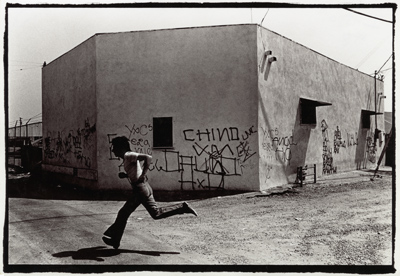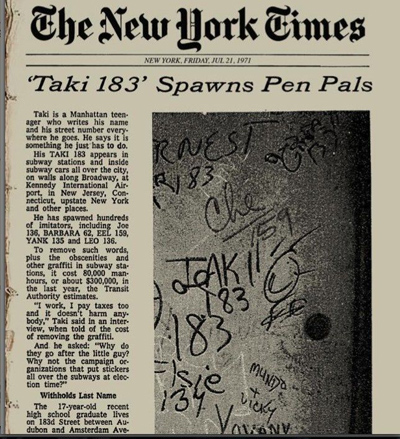Los Angeles MOCA's blockbuster "Art in the Streets" show has churned out one controversy after another, from the uproar over the whitewashing of Blu's antiwar murallast year and the concerns that the exhibition is embalming street art to the hand-wringing over copycat graffiti inspired by the show and the L.A. police department's stepped-up offensive against working street artists that has accompanied it. None of these issues should be particularly shocking. What is shocking is that the organizers of a show about graffiti history art would be caught so flatfooted by them.
 Graffiti artist Chaz running in a backstreet near Whittier Boulevard in East Los Angeles, 1974 / Photo by Gusmano Cesaretti
Graffiti artist Chaz running in a backstreet near Whittier Boulevard in East Los Angeles, 1974 / Photo by Gusmano Cesaretti"The audience at any showing of 'Style Wars'... always raises the same questions," Henry Chalfant explained in a 1987 essay on the classic graffiti film which, like "Art in the Streets," was intended to be an exuberant promotion of the phenomenon. And what issues were these? "Angry citizens berate us for encouraging vandalism everywhere," Chalfant said, while "the purists ask if we regret being part of a process that has destroyed urban folk culture." Which is to say, the issues that have dogged "Art in the Streets" are eternal ones when it comes to trying to document or capture the energy of graffiti. They are part of the package.
The New York Daily News fulminates against bringing "Art in the Streets" to New York, because of the potential for it to encourage vandalism -- but of course, graffiti culture is one of New York's big exports to the world, part of the quadfecta of Bronx-bred hip-hop culture, along with DJing, rap, and break dancing. As Jeff Chang narrates in his masterful "Can't Stop Won't Stop: A History of the Hip-Hop Generation," graffiti grew out of conditions the urban decay in the 1970s, as both a symbol of it and a reaction against it.
 Taki 183's write up in the New York Times, 1971
Taki 183's write up in the New York Times, 1971/ Courtesy Wooster Collective
Living in a visually pleasant environment is a human impulse, and something communities tend to strive towards when they are not completely besieged. When the Young Lords -- a Puerto Rican political group in the vein of the Black Panthers -- were seeking to organize in Spanish Harlem in the 1960s, they asked neighborhood denizens what their top priorities were. The answer they received, almost unanimously, was trash cleanup. So they organized a plan to collectively pick up garbage. Alas, the Young Lords were done in by "political infighting and F.B.I. infiltration," as the Times recently recalled. The problems of blight and neglect that had animated them remained, and indeed worsened as the stagnation of the 1970s set in.
Into this void stepped the gangs. The graffiti scene developed in dialogue with the gang practice of marking territory with tags, but whereas gang graffiti was about defining neighborhood borders, the classic New York graffiti writers were all about crossing boundaries. To a certain extent, this mercurial art form offered an alternative outlet for the angry and abandoned. The shape that graffiti art took represents an unresolved hybrid of fuck-the-law nihilism and grassroots urban beautification. The contradictions that haunt it today are the legacy of the contradictions that birthed it.
Viewing the fine art/street art dichotomy as a simple opposition is natural, but the relationship, while difficult, has also sometimes been synergistic. It is not a coincidence that graffiti first exploded in New York, with its concentration of media and creative industries. Taki 183 wasn't the first tagger, but he was the first to be profiled in the New York Times (in 1971), and the copycatting that this publicity inspired made the scene explode. Meanwhile, the New York art-world connection would bring some sense of larger importance to an activity previously thought of as having no future, from O.K. Harris gallery's 1980 show of graffiti photos to CoLab's woolly, up-with-people "Times Square Show." The road to New York-style graffiti's global influence came through its migration into downtown creative circles. By the time Fab Five Freddy was curating a graffiti show for the Mudd Club in 1981, Blondie was name-checking him in "Rapture," and rapping nonsensically about "eating cars."
Graffiti was born at a historic moment of artistic opening-up, after the "dematerialization of art" and the guerrilla urbanism of the Situationists, alongside performance and happenings, the alternative-space movement, and the pathos of post-minimalism. With its vibrant Wild Style colors, classic New York graffiti represented an implicit if unintentional rebuttal of conceptualism's cerebral, anti-visual character, even as it showed, concretely, what the idea that "everyone is an artist" means when put in practice. Joseph Beuys's dictum is encouragingly utopian, yet in real life, real hierarchies of power cramp and trouble what it might mean. Universal consumerism indeed augments the creative instruments at the disposal of the normal person -- a graffiti-art scene was made possible by consumer-accessible aerosol spray-paint -- but this potential is not matched by opportunities within the sphere of official culture for people to realize themselves as creative individuals.
 Zephr and Revolt Sharps' "Wild Style Mural," 1983 / Photo by Martha Coope
Zephr and Revolt Sharps' "Wild Style Mural," 1983 / Photo by Martha CoopeThe endless graffiti-as-art versus graffiti-as-vandalism debate is just a displaced version of the fundamental question raised by the tumultuous pluralism of contemporary aesthetics: "what is art?" In the case of graffiti, however, debate over the question is played out on the streets, where the cops and perfectly innocent, aggrieved small business owners get involved. The white cube serves to sterilize and contain the debate over what we call art, transmuting it into a question of abstract taste, when it is in fact a question of rival ideas of how society works, different communities, classes, and cultures. And not every one of these has equal access to the white cube.
The tremendous popularity of shows like "Art in the Streets" goes hand in hand with the troubled issues that haunt them. Not in the sense that controversy attracts media, which attracts crowds -- though I suppose there is some of that. Rather, in the sense that graffiti is a popular art; more people can identify with the illegal route to aesthetic self-expression than can identify with the esoteric route offered by traditional museum culture. Our society has a creative potential too massive to fit in the cramped confines of the official art world, and the attempt to squeeze this energy into these confines naturally exposes this contradiction rather than resolving it, as the fuss around "Art and the Streets" has demonstrated. Perhaps if the organizers of the L.A. MOCA show started from this perspective, then they would have an answer to the debates that have greeted the exhibition other than what they have now, which seems to amount to the bad parental logic of "do as I say, not as I do."
Interventions is a weekly column by ARTINFO deputy editor Ben Davis. He can be reached at bdavis@artinfo.com
-Ben Davis, ARTINFO
More of Today's News from ARTINFO:
Warholmania: A Preview of the 52 Warhols Hitting New York's Contemporary Art Auctions This Week
Thiebaud Took the Cake While Ab-Ex Struggled at Sotheby's $54.8 Million Allan Stone Collection Sale
Why the Getty's Choice of James Cuno as CEO Is Clueless
BMW Guggenheim Lab Brings Urban Innovation to a Literal Rat Hole
In the Outskirts of Paris, a Launching Pad for French Emerging Artists Heats Up
Like what you see? Sign up for ARTINFO's daily newsletter to get the latest on the market, emerging artists, auctions, galleries, museums, and more.






